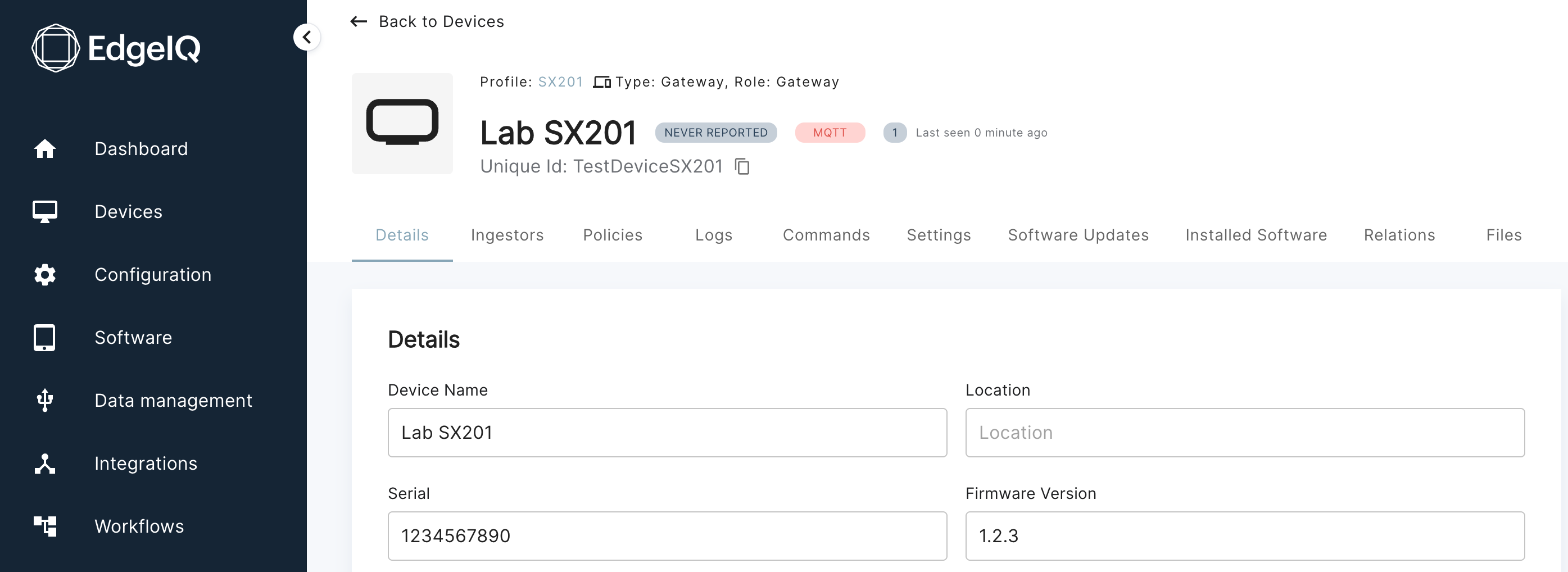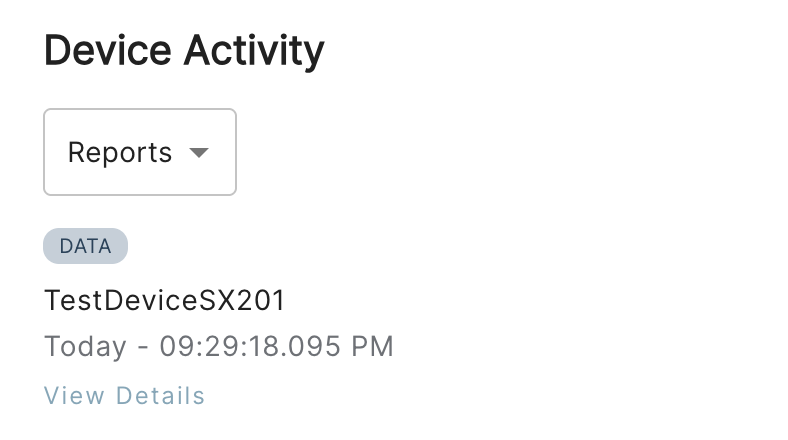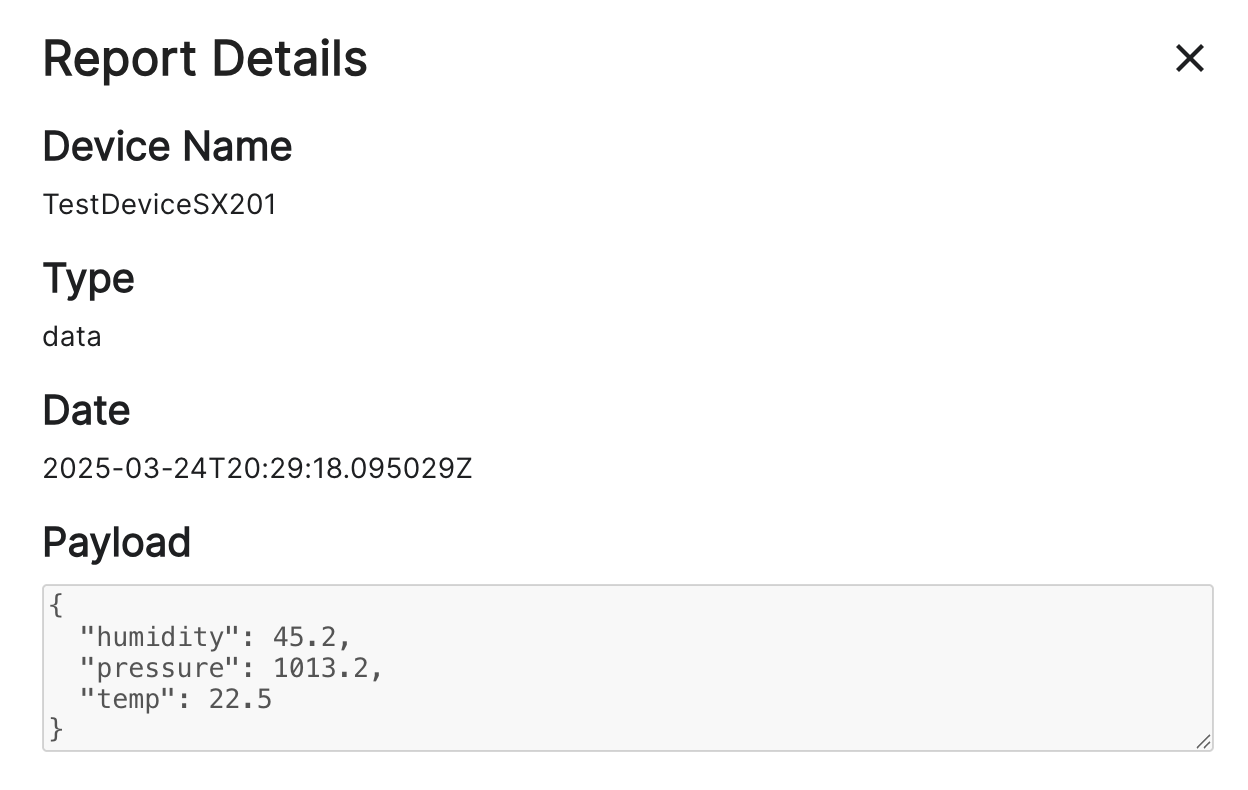Connecting devices via MQTT
Guide describing a direct MQTT connection, for example for small embedded devices with a custom firmware. No EdgeIQ Coda installation needed.
This guide explains how to integrate IoT devices with the EdgeIQ Symphony platform using MQTT. It covers the essential operations including connecting devices, sending reports, and transmitting heartbeats.
Table of Contents
Prerequisites
Before you begin, ensure you have:
- A registered device in the EdgeIQ Symphony platform
- Your company ID
- Your device ID
- Your device password
- Mosquitto MQTT client installed (to follow the examples)
MQTT Broker Information
EdgeIQ Symphony uses the following MQTT broker:
- Production Broker:
mqtt.edgeiq.io:443 - Protocol: MQTTS (MQTT over TLS)
- Port: 443
- AWS Root CA:
AmazonRootCA1.pem - TLS: Required (with ALPN protocol set to "mqtt")
Use Case 1: Connecting a Device via MQTT
Proper connection to the EdgeIQ Symphony platform requires specific formatting for client ID and username.
Connection Parameters
- Client ID:
<company_id>/<device_id>/custom-v1.2.3- the<custom-v1.2.3>part can be left empty or filled with your client name and version - Username:
<company_id>/<device_id> - Password: Your device password
- TLS: Required (with ALPN protocol set to "mqtt")
Example Connection Using Mosquitto
mosquitto_pub \
-h mqtt.edgeiq.io \
-p 443 \
-i "your_company/your_device_id/custom-v1.2.3" \
-u "your_company/your_device_id" \
-P "your_password" \
-t "u/your_company/your_device_id/status" \
-m '{"serial":"1234567890", "firmware_version":"1.2.3"}' \
--tls-use-os-certs \
--tls-alpn mqtt \
-q 1If the message was processed successfully, the Device Details page should be updated with the submitted information (Serial and Firmware Version). The connection counter chips should also indicate that the device was connected once:

Connection counter chip shows "1" connection and Serial and Firmware Version have been updated.
Connection Notes
- The client ID format includes a version string that helps identify your client software version
- TLS is mandatory for production environments
- Quality of Service (QoS) level 1 is recommended for most messages
Use Case 2: Sending a Report Message
Reports are used to send device data to the EdgeIQ Symphony platform. They follow a specific topic structure and payload format.
Report Topic Structure
u/<company_id>/<device_id>/reportsExample Report Message
mosquitto_pub \
-h mqtt.edgeiq.io \
-p 443 \
-t "u/your_company/your_device_id/reports" \
-u "your_company/your_device_id" \
-P "your_password" \
-i "your_company/your_device_id/custom-v1.2.3" \
-m '{"payload":{"temp":22.5,"humidity":45.2,"pressure":1013.2}}' \
--tls-use-os-certs \
--tls-alpn mqtt \
-q 1If the message was processed successfully, you should see the report under the Reports drop-down in the Device Activity sidebar:

Report appears in the Device Activity sidebar.

Opening the report shows the submitted payload.
Report Payload Structure
The basic report payload contains a payload object with your device data:
{
"payload": {
"temp": 22.5
}
}Extended Report Options
You can include additional fields in your report:
{
"device_unique_id": "your_device_id",
"device_datetime": "2023-06-15T12:34:56Z",
"payload": {
"temp": 22.5,
"humidity": 45.2
},
"seq": 123
}device_unique_id: Identifies the device (useful when sending on behalf of sensors)device_datetime: Timestamp when the data was collectedseq: Sequence number for tracking message order
Use Case 3: Sending a Heartbeat Message
Heartbeats provide operational metrics about your device to the EdgeIQ Symphony platform. To configure heartbeats, please set a Heartbeat Period on the Device Details page. The heartbeat period is used to trigger status changes to At Risk and Offline based on the time passed since the last heartbeat. A device is considered At Risk, if it missed at least one heartbeat, and Offline, if it missed more than 3 heartbeats.

Set a heartbeat period on the device details page.
Heartbeat Topic Structure
u/<company_id>/<device_id>/reports/hbExample Heartbeat Message
mosquitto_pub \
-h mqtt.edgeiq.io \
-p 443 \
-t "u/your_company/your_device_id/reports/hb" \
-u "your_company/your_device_id" \
-P "your_password" \
-i "your_company/your_device_id/custom-v1.2.3" \
-m '{"cpu_usage":"10","ram_usage":"50.2","disk_usage":"75.1"}' \
--tls-use-os-certs \
--tls-alpn mqtt \
-q 1After sending the message, the device status should change to Online. MQTT will report disconnected, because mosquitto_pub will connect, submit the message, and disconnect:

Device is marked online after the heartbeat message was received. The heartbeat message is shown under Device Activity.
Heartbeat Payload Structure
The heartbeat payload contains operational metrics:
{
"cpu_usage": "10",
"ram_usage": "50.2",
"disk_usage": "75.1"
}Extended Heartbeat Options
You can include additional fields in your heartbeat:
{
"status": "online",
"edge_version": "4.2.1",
"cell_signal": "excellent",
"cell_usage": "1.2GB",
"cpu_usage": "15",
"ram_usage": "50.2",
"disk_usage": "65.1",
"disk_size": "32GB",
"disk_free": "10.5GB",
"ips": ["192.168.1.100", "10.0.0.5"],
"connections": {
"ethernet": "connected",
"wifi": "connected",
"cellular": "connected"
},
"wifi_clients": ["device1", "device2"]
}Next Steps
Please refer to the EdgeIQ MQTT Device Spec for more advanced use cases.
Troubleshooting
Common Connection Issues
-
Connection Refused
- Verify your credentials (company ID, device ID, password)
- Ensure TLS is properly configured
- Check that the ALPN protocol is set to "mqtt"
- Check that the AWS Root CA is installed on the system or manually added to the truststore
-
Message Not Received
- Verify the topic format is correct
- Ensure the payload is valid JSON
- Check QoS level (1 is recommended)
-
TLS Errors
- Ensure your system has up-to-date CA certificates
- Try using the
--capathoption with a specific CA certificate
Debugging Tips
- Use the
-dflag with mosquitto_pub for verbose output - Check your device logs for connection errors
- Verify network connectivity to the broker
Additional Resources
EdgeIQ
MQTT
For more information or support, contact EdgeIQ support at [email protected].
Updated 3 months ago